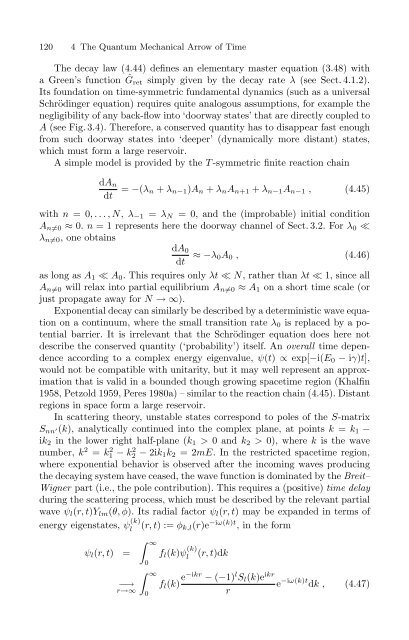The Physical Basis of The Direction of Time (The Frontiers ...
The Physical Basis of The Direction of Time (The Frontiers ...
The Physical Basis of The Direction of Time (The Frontiers ...
Create successful ePaper yourself
Turn your PDF publications into a flip-book with our unique Google optimized e-Paper software.
120 4 <strong>The</strong> Quantum Mechanical Arrow <strong>of</strong> <strong>Time</strong><br />
<strong>The</strong> decay law (4.44) defines an elementary master equation (3.48) with<br />
a Green’s function Ĝret simply given by the decay rate λ (see Sect. 4.1.2).<br />
Its foundation on time-symmetric fundamental dynamics (such as a universal<br />
Schrödinger equation) requires quite analogous assumptions, for example the<br />
negligibility <strong>of</strong> any back-flow into ‘doorway states’ that are directly coupled to<br />
A (see Fig. 3.4). <strong>The</strong>refore, a conserved quantity has to disappear fast enough<br />
from such doorway states into ‘deeper’ (dynamically more distant) states,<br />
which must form a large reservoir.<br />
A simple model is provided by the T -symmetric finite reaction chain<br />
dA n<br />
dt<br />
= −(λ n + λ n−1 )A n + λ n A n+1 + λ n−1 A n−1 , (4.45)<br />
with n =0,...,N, λ −1 = λ N = 0, and the (improbable) initial condition<br />
A n≠0 ≈ 0. n = 1 represents here the doorway channel <strong>of</strong> Sect. 3.2. For λ 0 ≪<br />
λ n≠0 , one obtains<br />
dA 0<br />
≈−λ 0 A 0 , (4.46)<br />
dt<br />
as long as A 1 ≪ A 0 . This requires only λt ≪ N, rather than λt ≪ 1, since all<br />
A n≠0 will relax into partial equilibrium A n≠0 ≈ A 1 on a short time scale (or<br />
just propagate away for N →∞).<br />
Exponential decay can similarly be described by a deterministic wave equation<br />
on a continuum, where the small transition rate λ 0 is replaced by a potential<br />
barrier. It is irrelevant that the Schrödinger equation does here not<br />
describe the conserved quantity (‘probability’) itself. An overall time dependence<br />
according to a complex energy eigenvalue, ψ(t) ∝ exp[−i(E 0 − iγ)t],<br />
would not be compatible with unitarity, but it may well represent an approximation<br />
that is valid in a bounded though growing spacetime region (Khalfin<br />
1958, Petzold 1959, Peres 1980a) – similar to the reaction chain (4.45). Distant<br />
regions in space form a large reservoir.<br />
In scattering theory, unstable states correspond to poles <strong>of</strong> the S-matrix<br />
S nn ′(k), analytically continued into the complex plane, at points k = k 1 −<br />
ik 2 in the lower right half-plane (k 1 > 0andk 2 > 0), where k is the wave<br />
number, k 2 = k1 2 − k2 2 − 2ik 1 k 2 =2mE. In the restricted spacetime region,<br />
where exponential behavior is observed after the incoming waves producing<br />
the decaying system have ceased, the wave function is dominated by the Breit–<br />
Wigner part (i.e., the pole contribution). This requires a (positive) time delay<br />
during the scattering process, which must be described by the relevant partial<br />
wave ψ l (r, t)Y lm (θ, φ). Its radial factor ψ l (r, t) may be expanded in terms <strong>of</strong><br />
energy eigenstates, ψ (k)<br />
l<br />
(r, t) :=φ k,l (r)e −iω(k)t , in the form<br />
ψ l (r, t) =<br />
−→<br />
r→∞<br />
∫ ∞<br />
0<br />
∫ ∞<br />
0<br />
f l (k)ψ (k)<br />
l<br />
(r, t)dk<br />
f l (k) e−ikr − (−1) l S l (k)e ikr<br />
e −iω(k)t dk, (4.47)<br />
r



![arXiv:1001.0993v1 [hep-ph] 6 Jan 2010](https://img.yumpu.com/51282177/1/190x245/arxiv10010993v1-hep-ph-6-jan-2010.jpg?quality=85)


![arXiv:1008.3907v2 [astro-ph.CO] 1 Nov 2011](https://img.yumpu.com/48909562/1/190x245/arxiv10083907v2-astro-phco-1-nov-2011.jpg?quality=85)








![arXiv:1002.4928v1 [gr-qc] 26 Feb 2010](https://img.yumpu.com/41209516/1/190x245/arxiv10024928v1-gr-qc-26-feb-2010.jpg?quality=85)
![arXiv:1206.2653v1 [astro-ph.CO] 12 Jun 2012](https://img.yumpu.com/39510078/1/190x245/arxiv12062653v1-astro-phco-12-jun-2012.jpg?quality=85)
